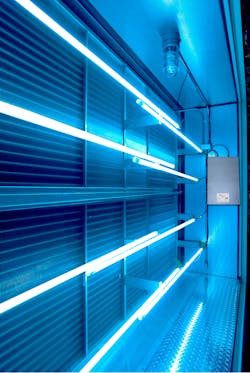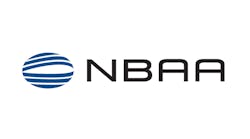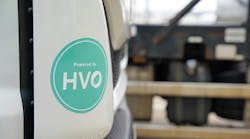The role of indoor air quality has become top of mind for the world’s leading airports. These transportation hubs serve millions of passengers, employ thousands of workers, and occupy millions of square feet. As a result, many airport facility directors are turning to ultraviolet germicidal light (UV C) to combat pathogens that grow in and travel through HVAC systems. It’s a preventive measure that protects people, improves HVAC performance, and saves energy.
UV disinfection is an established technology that dates to the 1930s, and it inactivates mold, viruses, and bacteria. According to industry experts, the 253.7nm wavelength damages the genetic structure of microorganisms, rendering them inert and unable to reproduce. It is effective on airborne particulates and those growing on surfaces. This surface and airstream disinfection property is a critical advantage inside commercial HVAC systems, where germs can proliferate.
Airports are smart to adopt UV‑C. Researchers note that UV-C is a vital safeguard against infectious diseases, including the SARS-CoV-2 virus. There are many studies that demonstrate how germicidal irradiation kills contagious particles like the rhinovirus (common cold), influenza and legionella (Legionnaires’ disease).
UV‑C also delivers significant operational savings. Biologic growth in commercial air handlers is a major source of poor HVAC performance, compromising components, so they are no longer efficient in their function, according to field measurements. UV‑C energy penetrates deep into the HVAC coil, eliminating performance-robbing and odor-causing microbial build-up that can’t be reached by pressure washing or chemical treatment.
Other benefits includes:
- Works inside air handling units of any brand, size, or age
- Pairs with ASHRAE-recommended air quality protections such as high-efficiency HVAC air filters, minimum air changes per hour, ensuring humidity design set points, etc.
- Improves airflow and restores cooling capacity to near-original design specifications
- Boosts coil-heat exchanger efficiency, thereby lowering HVAC energy use
- Endorsed by CDC, ASHRAE, and Airports Council International
UV‑C is also a safe way to eradicate germs. The fixtures are installed directly within an HVAC system, so there’s no human exposure to the light. It doesn’t use chemicals or create harmful byproducts like VOCs or ozone.
UV Resources has worked with two of the busiest airports in the U.S. – Dallas Fort Worth and Los Angeles International. Both airports have been pleased to experience the air quality, maintenance, and efficiency benefits of UV‑C.
LAX
Musty odors have no place in an airport, yet the inside of an HVAC system can be a breeding ground for the fungus responsible for generating unsightly smells. Airports like Los Angeles International (LAX) constantly use manual HVAC cleaning and harsh chemicals to combat this tenacious biofilm. UV‑C fixtures installed in air handler units (AHUs) or ductwork offer a permanent, automatic solution.
LAX opted to install UV‑C fixtures in more than 200 AHUs. The technology has been so effective that UV‑C irradiation is now the airport’s mechanical design standard. It meets LAX’s requirements for durability – 24/7 operation, a 20-year lifespan, and compatibility with new and legacy systems.
UV‑C not only protects airport passengers and staff from pathogens but also improves HVAC performance. Organic buildup on coils interferes with an efficient heat transfer process causing efficiency and cooling performance to drop. After installing the UV Resources germicidal fixtures, LAX measured a 15% increase in airflow after a single-week sample test — equivalent to recovering 2,000 CFM. UV‑C has significantly cut down on the amount of time needed for manual coil cleanings as well.
Having passed this test, the UV lamps were added to more than 75 other air handlers across the facility. An added benefit has been the maintenance savings — upwards of $180,000 annually — from eliminating manual HVAC coil cleanings.
LAX specified UV Resources’ High-Output DEF series to keep its 48 million passengers safe across nine terminals and 145+ gates. This model generates double the irradiation levels of standard fixtures. In addition, its flexibility works with any AHU regardless of manufacturer, capacity or age. This is ideal for LAX, which has AHUs ranging in size from 5 to 40 tons, some of which use up to 24 UV‑C fixtures.
DFW
Dallas Fort Worth International (DFW) Airport embarked on an extensive HVAC retrofit of UV‑C starting in 2020. It is part of a suite of mitigation strategies that reduce the risk of infectious pathogens from airborne and surface transmissions. UV‑C now protects DFW’s 62.5 million travelers throughout its five terminals and 185+ gates.
The upgrade began with 28 AHUs serving high-traffic locations such as security checkpoints and tickets. The RLM Xtreme fixtureless UV‑C lamp system from UV Resources was specified for its high-output performance and installation versatility
Designed for high-volume HVAC environments, the versatile RLM Xtreme can be installed in almost any position to generate 360-degree high output UV‑C irradiation to inactivate bacteria, viruses, molds, and other pathogens–including antibiotic-resistant superbugs. The uniform 360-degree distribution provides the best air treatment effectiveness and is consistent with ASHRAE Handbook guidance.
The next phase added UV‑C in each of the 250+ AHUs to disinfect airstreams and keep the coil, drain pan and plenum free of infection-causing and efficiency-robbing microorganisms.
Because the UV‑C disinfection fixtures are installed inside the airport’s air handling units, virtually all occupied spaces will receive air treated by the UV‑C systems. As air is recirculated, concentrations of infectious pathogens can be further reduced by each subsequent pass or cycle through the HVAC system, known as “multiple dosing.”
And, unlike some other air disinfection technologies, UV‑C’s electromagnetic energy does not “add” chemicals, VOCs, or dangerous byproducts to the environment.
After observing the potential benefits of the newly installed germicidal disinfection system, DFW facilities staff agrees that this technology has become an important component of the ever-increasing infection mitigation controls for the fourth busiest airport in the world.
In more ways than one, UV‑C fixtures installed AHUs or HVAC ductwork ensure everyone at DFW and LAX breathes more easily.
UV Resources Vice President and Co-Founder Dean Saputa currently serves as chair of ASHRAE SPC‑185.2 (Method of Testing Ultraviolet Lamps) and as secretary of GPC‑37, Guidelines for the Application of Upper‑Air Ultraviolet Germicidal Devices to Control the Transmission of Airborne Pathogens. He can be reached at [email protected]




